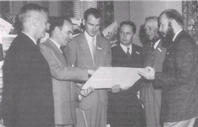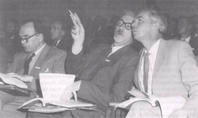


Memories of the Bureau, 1946 to 1962
Foreword
Terminology
Prologue
Preface
Chapter 1: The Warren Years, 1946 to 1950
Chapter 2: International Meteorology
Chapter 3: The Timcke Years, 1950 to 1955
Chapter 4: A Year at the Massachusetts Institute of Technology
Chapter 5: The Dwyer Years, 1955 to 1962
Leonard Joseph Dwyer—A Complex Character
Reorganising the Bureau
Public Weather Services
Forecasts for the General Public
Importance of Radio Stations
The Advent of Television
Automatic Telephone Forecast Service
Beacons
Wording and Verification of Forecasts
Warnings
Services for Aviation
Atomic Weapons Tests
Atomic Weapons Tests—Mosaic G1 and G2
Atomic Weapons Tests—Buffalo 1, 2, 3 and 4
Atomic Weapons Tests—Operations Antler, 2 and 3
Atomic Weapons Tests—Minor Trials
Instruments and Observations
Radiosondes
Radar/Radio Winds and Radar Weather Watch
Automatic Weather Stations
Sferics
Meteorological Satellites
Telecommunications
Tropical Cyclones
Bureau Conference on Tropical Cyclones
International Symposium on Tropical Cyclones, Brisbane
Hydrometeorology
Design of Water Storages, Etc
Flood Forecasting
Cloud Seeding
Reduction of Evaporation
Rain Seminar
Cloud Physics
Fire Weather
Research and Special Investigations
International Activities
The International Geophysical Year
The Antarctic and Southern Ocean
International Symposium on Antarctic Meteorology
International Antarctic Analysis Centre
ADP, EDP and Computers
Training
Publications
Management Conference
Services Conference
CSIRO and the Universities
Achievements of the Dwyer Years
Chapter 6: A Springboard for the Future
Appendix 1: References
Appendix 2: Reports, Papers, Manuscripts
Appendix 3: Milestones
Appendix 4: Acknowledgements
Appendix 5: Summary by H. N. Warren of the Operation of the Meteorological Section of Allied Air Headquarters, Brisbane, 1942–45
Endnotes
Index
Search
Help
Contact us

International Symposium on Antarctic Meteorology (continued)
The 45 Australian participants included representatives from ANARE, ARL, CSIRO, DCA, RAN, RAAF, SMHEA, Universities of Melbourne, New England and Queensland, WRE and 21 members of the Bureau's staff. Many of the local and overseas participants were meteorologists who had seen service in the Arctic or Antarctic. Professor H. C. Webster represented the Australian National Committee for the IGY and Bill Priestley the Academy of Science.The symposium was opened by the Hon Gordon Freeth, Minister for the Interior, supported by Sir Arthur Warner, representing the Government of Victoria, Bill Priestley and Len Dwyer. Forty papers were presented in seven sessions, subjects being local effects, synoptic analysis and forecasting, influences on lower latitudes, circulation studies, snow and ice, heat and mass exchanges and climatological aspects. The presentation of papers was followed by animated discussion and a summing-up by the session chairman. Sessions were chaired by Gabites, Gibbs, Langlo, Robin, Bill Priestley, Taljaard and Van Mieghem. I had met many of the overseas participants and was well acquainted with most of the Australian participants. Attendance at the symposium was an indication of the high regard in which the Bureau was held by Antarctic scientists in Australia and overseas.


Space does not permit a detailed review of papers presented and discussions which took place but the Bureau was able to arrange the publication of an elegantly printed, hard-cover volume of 483 pages. A brief summary of papers presented was followed by the full text and illustrations of papers presented and a summary of the discussions. The volume was published by Pergamon Press in 1960 after assembly by the Bureau.
The important subject of the katabatic wind of the Antarctic continent was discussed in a number of papers and produced considerable animated discussion. Another series of papers concerning the circulation of the atmosphere over and adjacent to the continent was important not only for synoptic analysis and forecasting but also because of the likely effect on the circulation in lower latitudes. A paper of special interest was that by Reg Clarke of CSIRO which presented the results of a series of laboratory experiments using a cylindrical tank with heating at the rim and a cold area or dome at the centre, inspired by similar experiments by Pultz. Papers by Astapenko, Gibbs and Langford discussed frontal analysis over the Southern Ocean which had particular relevance to forecasting in southern latitudes of Australia, South America and South Africa.
One of the special topics of the IGY had been the exploration of the upper atmosphere and a paper by Vic Hopper and Jean Laby of the Physics Department of the University of Melbourne discussed winds at levels from 40 000 to 110 000 feet over Australia.
People in Bright Sparcs - Clarke, Reginald Henry; Dwyer, Leonard Joseph; Priestley, Charles Henry Brian (Bill)
 |
Bureau of Meteorology |  |
© Online Edition Australian Science and Technology Heritage Centre and Bureau of Meteorology 2001
Published by Australian Science and Technology Heritage Centre, using the Web Academic Resource Publisher
http://www.austehc.unimelb.edu.au/fam/1117.html